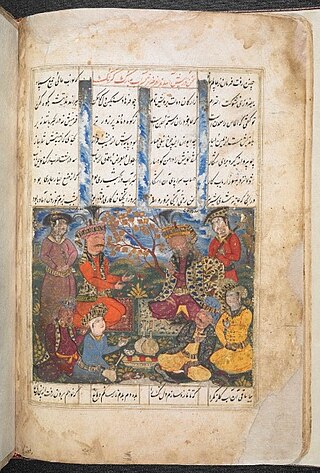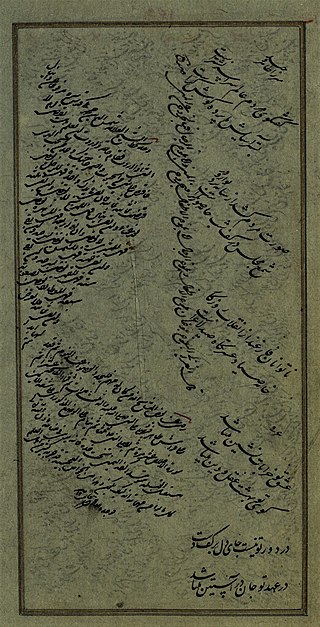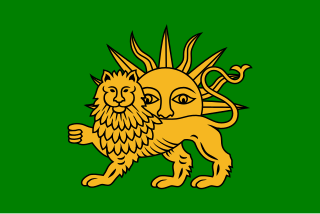Related Research Articles

A velayat was a type of administrative division within Safavid Iran, which functioned as a semi-autonomous province.
Ardalan was a hereditary Kurdish vassaldom in western Iran from around the 14th century until 1865 or 1868 with Sanandaj as capital. The territory corresponded roughly to present-day Kurdistan Province of Iran and the rulers were loyal to the Qajar Empire. Baban was its main rival. Gorani was the literary language and lingua franca. When the vassaldom fell, literary work in Gorani ceased.

Sam Mirza, known by his dynastic name of Shah Safi, was the sixth shah of Safavid Iran, ruling from 1629 to 1642. Abbas the Great was succeeded by his grandson, Safi. A reclusive and passive character, Safi was unable to fill the power vacuum which his grandfather had left behind. His officials undermined his authority and revolts constantly broke out across the realm. The continuing war with the Ottoman Empire, started with initial success during Abbas the Great's reign, but ended with the humiliating defeat of Iran and the Treaty of Zuhab, which returned much of Iran's conquests in Mesopotamia to the Ottomans.

Suleiman I was the eighth Shah of Safavid Iran from 1666 to 1694. He was the eldest son of Abbas II and his concubine, Nakihat Khanum. Born as Sam Mirza, Suleiman spent his childhood in the harem among women and eunuchs and his existence was hidden from the public. In 1666, after the death of his father, the nineteen-year-old Sam Mirza was crowned king under the regnal name, Safi II, after his grandfather, Safi I. He had a troublesome reign as Safi II, which convinced his court astrologers that he should undergo a coronation once again. Thus, in 20 March 1668, simultaneously with Nowruz, he was crowned king with a new name, Suleiman I.

Abbas II was the seventh Shah of Safavid Iran, ruling from 1642 to 1666. As the eldest son of Safi and his Circassian wife, Anna Khanum, he inherited the throne when he was nine, and had to rely on a regency led by Saru Taqi, the erstwhile grand vizier of his father, to govern in his place. During the regency, Abbas received formal kingly education that, until then, he had been denied. In 1645, at age fifteen, he was able to remove Saru Taqi from power, and after purging the bureaucracy ranks, asserted his authority over his court and began his absolute rule.

Allahverdi Khan was an Iranian general and statesman of Georgian origin who, initially a gholām, rose to high office in the Safavid state.
Shaykh Ali Khan Zanganeh, was an Iranian statesman of Kurdish origin, who served as the grand vizier of the Safavid king (shah) Suleiman I from 1669 to 1689. Due to his efforts in reforming the declining Iranian economy, he has been called the "Safavid Amir Kabir" in modern historiography.

Mirza Mohammad Taqi, better known as Saru Taqi was a eunuch in Safavid Iran, who served as the Grand Vizier of the Safavid king (shah) Safi and the latter's son Abbas II until he was assassinated on 11 October 1645.
Mohammad Beg, was a Muslim of Armenian origin, who served as the Grand Vizier of the Safavid king (shah) Abbas II from 1654 to 1661.

Mirza Mohammad Taher Vahid Qazvini, was an Iranian bureaucrat, poet, and historian, who served as the grand vizier of two Safavid monarchs, Shah Suleiman and the latter's son Soltan Hoseyn from 1691 to 1699.
The Moqaddam family are a Turkic tribe/family centered in the Iranian town of Maragheh. They were created by the Safavid monarch Shah Abbas I as part of his policy to redistribute land as well as the restructure provincial governmental and tribal structures.

The province of Georgia was a velayat (province) of Safavid Iran located in the area of present-day Georgia. The territory of the province was principally made up of the two subordinate eastern Georgian kingdoms of Kartli and Kakheti and, briefly, parts of the Principality of Samtskhe. The city of Tiflis was its administrative center, the base of Safavid power in the province, and the seat of the rulers of Kartli. It also housed an important Safavid mint.

The province of Daghestan was a province of Safavid Iran, centred on the territory of the present-day Republic of Dagestan. Numerous high-ranking Safavid figures originally hailed from the province, or had roots there.

The Safavid occupation of Basra (1697–1701) took place between 26 March 1697 and 9 March 1701. It was the second time that the important Persian Gulf city had fallen to Safavid Iran.

The province of Khuzestan was a southwestern province of Safavid Iran, corresponding to the present-day province of Khuzestan.
The province of Lorestan was a western province of Safavid Iran, corresponding to the present-day provinces of Ilam and Lorestan. It was one of the five velayats of the country, and was thus ruled by a vali.
Soleyman Khan Ardalan was the Ardalan beglerbeg (governor) of Kurdistan from 1637 to 1657. He is notable for having founded the city of Sanandaj in 1636/37, which would serve as the capital of the Ardalan principality until its dissolution in the 1860s. He was the cousin of Khan Ahmad Khan Ardalan, who had previously served as the governor of Kurdistan from 1617 to 1637. Following the Iranian–Ottoman Treaty of Zohab in 1639, Soleyman Khan lost the western half of his domain to the Ottomans, which included Shahrezur, Qaradagh, Qezelja, Sarutchek, Kirkuk, Rawandez, Emayideh, Koy, Harir and the western portion of Avraman. The extent of Kurdistan was thus now restricted to that of Sanandaj, Marivan, eastern Avraman, Baneh, Saqqeh, Javanrud, and some of the Jaf confederacy.
The province of Kurdistan was a western province of Safavid Iran, whose size varied throughout its existence due to political and military developments.
Khosrow Khan Ardalan was the Ardalan beglerbeg (governor) of Kurdistan from 1680 to 1682. He was unpopular amongst his subjects, who claimed that his rule was oppressive. He was counselled several times to improve his way of governing, but they all proved ineffective. As a result, he was summoned to Isfahan, where he was executed at the Royal Square. He was replaced by Timur Khan Ajarlu Shamlu, the first non-Kurdish governor of the province.
Timur Khan Ajarlu Shamlu was the Safavid-appointed governor of Kurdistan from 1682 to 1688. Following the execution of the unpopular governor Khosrow Khan Ardalan, Shah Solayman had him replaced with Timur Khan, who became the first non-Kurdish governor of the province. Since Timur Khan was a foreigner with no connection to the province, he was eventually chased out by the locals. In 1688, he was replaced by Khan Ahmad Khan II Ardalan.
References
- ↑ Floor 2008, p. 228.
- 1 2 3 Yamaguchi 2021, p. 565.
- ↑ Yamaguchi 2021.
- ↑ Matthee 2015, p. 447.
- ↑ Yamaguchi 2021, p. 145.
- ↑ Floor 2008, pp. 227–228.